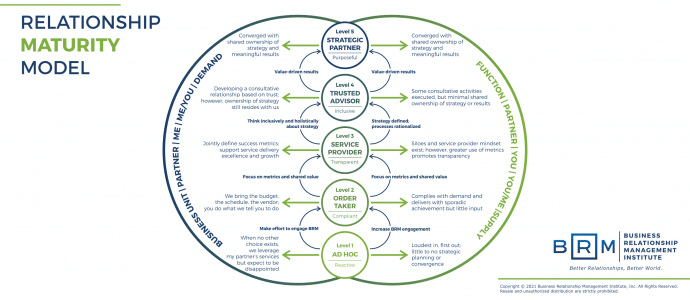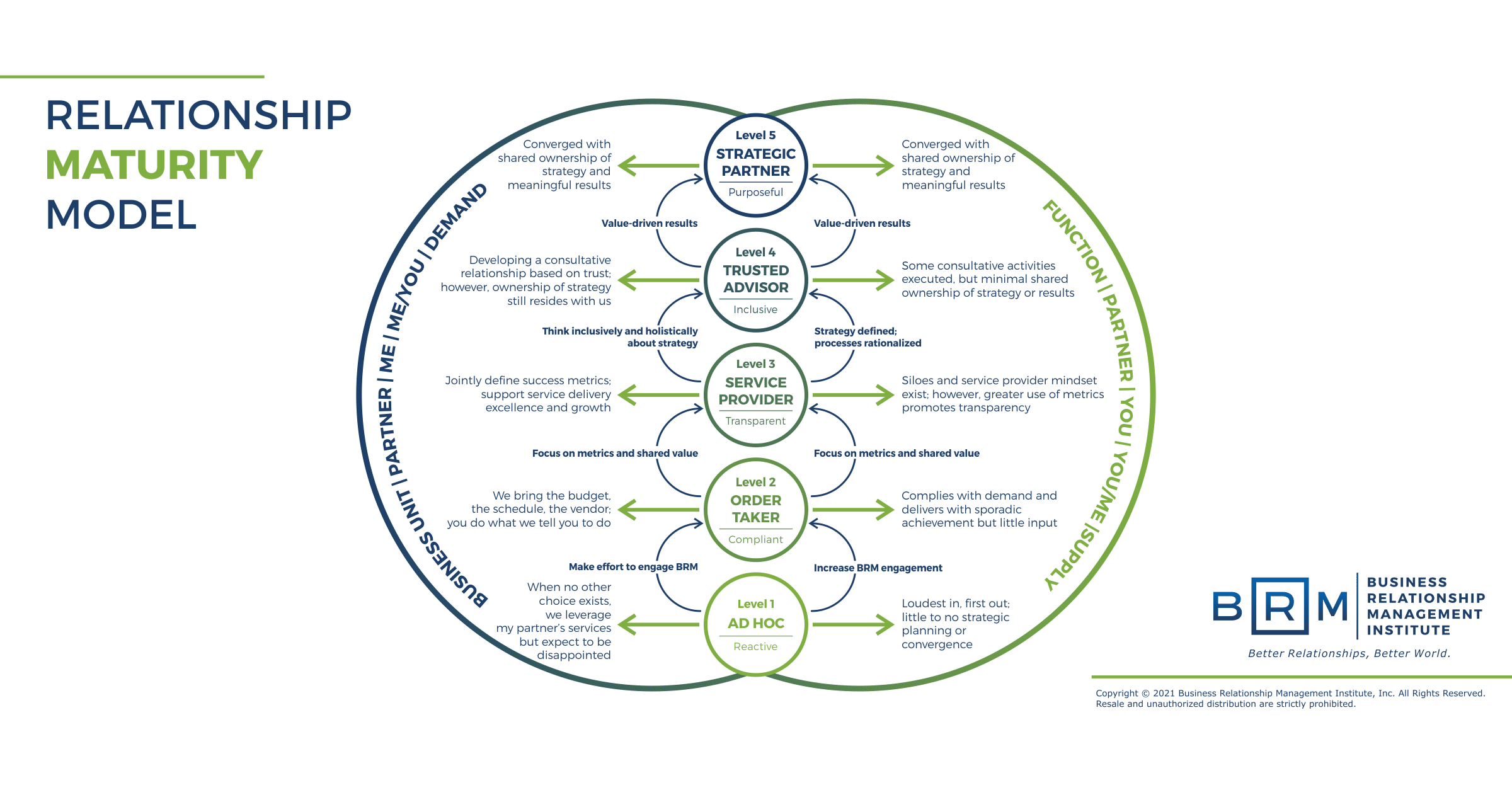Business Relationship Manager (BRM) Metrics

It comes as no surprise; executives frequently ask for business relationship management (BRM) metrics and the financial value added to the organization through the BRM capability.
If you already have a well-defined process in place to measure and communicate the real value through key performance indicators (KPIs), congratulations!
But if not, don’t despair—the following is an overview on how to set up both individual BRM metrics and high-level financial value reporting.
Setting the Stage
The Business Relationship Management Body of Knowledge (BRMBOK) defines the BRM role as the set of competencies required to advance the BRM capability, which is everything it takes, both visible and invisible, to nurture relationships in an organization. As a result, the BRM evolves culture, builds partnerships, and drives value, all to satisfy organizational purpose.
The first step toward doing this is to immediately establish the following seven metrics for your BRMs. Ultimately, your objective should be to maintain these metrics going forward. What’s more, these metrics can be used for all relationship maturity levels:
1. All ideas have an idea document.
2. All ideas have a value plan.
3. All relationships have a strategic relationship plan which is routinely updated and includes the following:
- Building a relationship strategy on a page (RSOAP).
- Routine review of relationship maturity assessment results (performed every six months).
- Routine review of function-level BRM SWOT results (performed as necessary, varying by function and changing over time).
- Plans to pull external perspectives into your organization (this can be achieved through conferences, meeting with end users, etc.).
4. All functions have established and documented a multi-year organizational strategy.
5. All functions have established and documented three-to-five KPIs.
6. There is a defined and documented multi-year capability roadmap based on organizational strategy.
7. Defined plans articulating the organizational value both accomplished and aimed for, based on maturity level (defined below).
It’s important to understand that business relationship management metrics are closely correlated with the following:
- The individual BRM’s skill level.
- The level of relationship maturity between the BRM and their strategic partners.
- The maturity of the BRM’s enabling function.
BRM Institute defines the five levels of relationship maturity through the Relationship Maturity Model, shown here:
The five levels are:
1. Ad Hoc
2. Order Taker
3. Service Partner
4. Trusted Advisor
5. Strategic Partner
Levels 1 and 2 – Loudest-in, first-out or frequent misrepresentations build mistrust and reactive course changes.
Low Maturity – Ad Hoc or Order Taker
If you’re only just starting out with your BRM capability, typically all you have in terms of performance metrics are satisfaction surveys that assess your partners’ opinions on the enabling function’s service delivery. The problem is, satisfaction surveys tend to be subjective, meaning they often reflect how someone feels on a particular day than an accurate overall indicator of value added.
With that said, you can still glean useful information from surveys. As long as the results are tabulated and built into an action plan, they’re still worth doing from time to time (for example, every six months or so).
Level 3 –
Routine is routine; innovation is a challenge.
Mid-Level Maturity – Service Provider
If you’re at the mid-maturity level, you probably spend most of your day reporting on routine metrics (i.e., “How well do we keep the lights on and the trains running?”). While this is important, the truth is that the organization likely cares very little about this information: It’s a given that you can keep the lights on and trains running.
Instead, make an effort to stop routine reporting externally, and find something of greater value to report as achievements.
Begin reflecting on how to report the value most relevant to organizational progress and results, in order to ensure you’re communicating the value of your contributions to provider areas outside your function.
Level 4 –
Build cooperation based on mutual respect and understanding.
Moving Up in Maturity – Trusted Advisor
As a trusted advisor, you are well on your way to shaping demand and partnering with the organization to decide which ideas can be turned into business cases worthy of review and approval. At this maturity level, a key metric for BRMs is the financial value of projects that were “approved to start” through the demand-shaping process (referred to as ideation).
For BRMs starting out, it’s a good idea to assign goals of achieving $X financial value to the organization in “approved-to-start” projects during their initial year or two.
This metric will get BRMs focused on building successful business cases that drive real financial value to the organization.
Note the emphasis on “approved-to-start” projects and not “delivered” projects. BRMs starting out can easily influence the projects that are brought forward to the organization through business cases, but influencing the actual delivery of these projects from the enabling function (resulting in true value realization) will come from more senior/experienced teams.
Level 5 –
Share goals for maximizing organization value; share risks and rewards.
Highest Maturity – Strategic Partner
At the strategic partner level, first ensure you have full value management in place before setting goals. Next, give your BRMs goals for the financial value (both tangible and intangible) realized by the individual function. You get here by defining the KPIs or financial value drivers with your partners for their particular function. This usually consists of three to five KPIs.
In the ideation phase, create value management plans and ensure projects that move forward truly impact the KPIs. Leverage the KPIs to say “no” to projects that fail to move the needle. Ensure that value optimization and realization occurs, as defined in the Value Management section of the BRM Interactive Body of Knowledge (BRMiBOK). BRMs can then report out on the amount of true financial value the partner realized in conjunction with the full provider.
At the strategic partner level, BRMs can also report on the financial value realized across the organization.
By summing up the individual BRM value realization reports, you now have financial value that can be shared across the organization. Your CEO and executive leadership will love this.
Other Metrics
It’s important to track the number of projects met with a “no.”
BRMs must show how they shape demand, rather than being a glorified salesperson who just drums up new demand all the time. Establishing KPIs by function empowers both the organization and the BRM to truly shape demand and only move the projects forward that move the needle with respect to value realization. Capturing paused ideas is a valuable metric to report on.
For Professional BRM Institute members, leverage other metric tools listed in the BRMiBOK on the Online Campus:
How to Implement Value Tracking and BRM Metrics
The mission of BRM is to evolve culture, build partnerships, drive value, and satisfy purpose in every organization.
Every organization is made up of relationships. Therefore, every organization has an existing, active BRM capability to fulfill its mission by nurturing as many relationships as possible. By fulfilling the mission of BRM, organizations can continuously evolve to meet the demands of a rapidly changing environment.
BRM Institute‘s shared purpose, then, is to serve as a beacon for the BRM capability. This purpose provides context around which people build relationships and drive value. According to the theory of relationshipism, relationships founded on an authentic, shared purpose evolve culture which, in turn, becomes a limitless source of organizational energy. That energy is what forever fuels the conception of strategy and the will to engage that strategy to satisfy the purpose.
While organizational purpose and strategy serve an organization in many capacities, the two in synergy with one another promote great relationships, and BRMs masterfully harness this unification when evolving culture, building partnerships, and driving value.
BRM Institute has various yearly membership packages that can be customized to help ensure that the progress of your BRM capability thrives through the metrics above. If you’re not already a member of this supportive community, consider joining to launch your career and your team to greater heights!

Very similar in concept to the old capability maturity model – but I love it! Pretty useful to be used to gauge what some BRMS in my organization might be missing as we progress in developing them. Thanks for the good article.
That is very fascinating, You are an overly skilled blogger.
I’ve joined your feed and sit up for searching for extra of your fantastic post.
Also, I have shared your website in my social networks
excellent issues altogether, you just received a emblem new reader.
What would you recommend in regards to your put up that you made
some days ago? Any certain?
Hello. Me ha fascinado ojear tu post. Me ha afinado una interpretación muy cautivadora, sin embargo, en determinados asuntos difiero un poco de su juicio.
He resuelto que tiene más difusiones, propongo tomarme un lapso para interpretarlas.
Ten por evidente que escoltaré todas tus manifestaciones.
Te congratulo por tu página web. Un afectuoso saludo.
If you truly wat the work, usually do not walk out
iin tthe intefview without saying so. You’re entirely
moe comfortable with the body, your age along with your income for your matter.
Your elevator pitch can be a 30 second or less statement about
why you need to get the task.
Those who are eking by on very nominal budgets usually have
neeeds that extend beyond food. Therefore, choosing organicc clothes oon the others can be a
worthwhile option. It cann be a good plan for ladies to own an idea of the style and hue of dress that they are seeking in advance oof time.
Many aspiring designers will have their possibility to shine by appearing solely for this unprecedented men’s
fashion week event. The garment coves the arks annd torso and comes usually in a very woolen maaterial but can be
also produced with cotton or any other varieties of
fabrics includsing synthetics. T Shirts best known as men’s sleepers, are also fashionable, that’s basically a big
t-shirt, originally worn as being a night shirt ass opposed to pajamas.
Very noce write-up. I definitely love this site. Thanks!
Thanks for the marvelous posting! I definitely
enjoyed reading it, you happen to be a great author.
I will ensure that I bookmark your blog and will eventually come back at some point.
I want to encourage yourself to continue your great work, have
a nice weekend!
I think this is among the most vital info for me. And i am glad
reading your article. But should remark on few general things,
The web site style is ideal, the articles is really nice : D.
Good job, cheers
[…] organizational capability with a clear mission, processes, roles and responsibilities, and metrics that can be summarized succinctly into evolve culture, build partnerships, drive value. Ultimately, […]
[…] soulignant que la transformation sera progressive. Créé en 2013, le BRM Institute établit ainsi cinq niveaux de maturité : ad hoc, order taker, service partner, trusted advisor, strategic […]